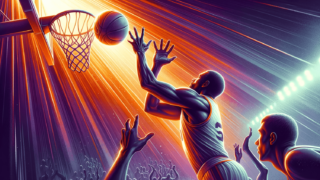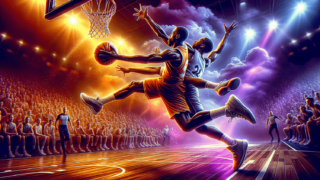
Basketball Foul-Out Rule: Impact on Player Performance
Written by: Basketball Universe
Last updated:

Welcome to the thrilling world of basketball, where every rule is designed to make the game a perfect blend of competitive fun and professionalism! In today’s blog post, we’re diving deep into one of the most intriguing aspects of the game – the Basketball Foul-Out Rule. Get ready for a slam dunk of knowledge as we explore how this rule impacts player performance and challenge your understanding of basketball dynamics. Let’s dribble our way into the details, shall we?
Basketball Foul-Out Rule: Impact on Player Performance
The Basketball Foul-Out Rule impacts player performance by limiting the number of personal fouls a player can commit before being disqualified from the game. In the NBA, college, and professional leagues, a player is fouled out after committing six personal fouls, while in high school basketball, the limit is typically five. This rule encourages players to adopt a strategic approach and forces coaches to make key decisions on substitutions and game plans. As a result, players must balance their defensive aggressiveness with the risk of fouling out, which affects their overall performance and team dynamics.
Understanding the Basics of Fouls and Foul-Outs
Before diving deeper into the basketball foul-out rule, let’s first grasp the fundamentals of fouls in basketball. A foul is a rule violation most often committed when a defensive player makes illegal contact with an offensive player. Different types of fouls are personal fouls, technical fouls, flagrant fouls, and team fouls. As we focus on the impact of the foul-out rule on player performance, it’s essential to note that this rule specifically pertains to personal fouls.
A personal foul occurs when illegal physical contact takes place between players. In the world of basketball rules, personal fouls are the most common type of fouls, which can result in free throws for the opposing team or a change in possession. The foul-out rule states that after a certain number of personal fouls, a player is disqualified from the game. This threshold varies depending on the league: six fouls in the NBA, NCAA, and most professional leagues, and five fouls in high school basketball.
The Strategic Allure of the Foul-Out Rule
Emphasizing the Importance of Discipline
The foul-out rule encourages players to display discipline throughout the game. This means finding the right balance between making assertive defensive plays and avoiding excessive physical contact. Developing this discipline can significantly improve a player’s overall performance, contributing to more successful individual and team outcomes.
Forcing Coaches to Make Decisions
As a player reaches the limit of personal fouls, they inch closer to the risk of fouling out. This situation puts pressure on coaches to make critical decisions on whether to keep those players on the floor or substitute them with others. As a result, the foul-out rule compels coaches to plan strategically and adapt their game plans accordingly.
A Deeper Dive into the Impact of Fouls and Foul-Outs on Performance
Defensive Adjustments
When players are in foul trouble, their defensive approach begins to change. They may become more conservative and avoid aggressive moves that could result in additional fouls. This restraint may result in a decrease in their defensive impact, leading to more scoring opportunities for the opponents. Consequently, careful defensive adjustments are essential when trying to avoid fouling out and maintaining a strong defense.
Offensive Tactics
Offensive players can also use the foul-out rule to their advantage by targeting opposing players with high foul counts. By driving towards these players and forcing them into making a defensive play, the offensive player aims to draw more fouls and potentially eliminate key defenders from the game. This strategy can open up more scoring opportunities and negatively impact the opposing team’s performance.
Foul Trouble: The Mental Game
The mental aspects of basketball are just as crucial as the physical ones, and the foul-out rule is no exception. When a player is in foul trouble, the psychological pressure of trying to avoid additional fouls can distract them from their usual game. Anxiety may lead to hesitations and a general avoidance of physical play. Embracing a strong mental game can aid in maintaining focus while navigating foul trouble.
Managing Fouls: Insightful Tips for Players and Coaches
For Players:
1. Improve Defensive Positioning: Enhancing your defensive position can significantly reduce the likelihood of committing fouls. Stay low, maintain balance, and keep your feet moving to keep up with your opponents without getting too physical.
2. Hands Up: Rather than reaching for a steal or swiping at the ball, keep your hands up when contesting shots or defending an opponent. This approach minimizes the chances of getting called for a foul.
3. Develop a Strong Mental Game: Don’t let foul trouble get inside your head. Mentally prepare yourself for the pressure of being in foul trouble, and learn how to adapt to the game without overthinking it.
For Coaches:
1. Teach Proper Defensive Techniques: Emphasize the importance of legal defensive moves and positioning during practices. Working on these fundamentals will inevitably decrease a player’s fouling tendencies.
2. Monitor and Manage Players’ Fouls: Keep track of your players’ fouls throughout the game, and make adjustments to your lineup based on this information. Timely substitutions can be vital to the success of your team.
3. Encourage Smart Play: Encourage your players to make smart decisions on the court, from their shot selection to how they engage with opponents defensively. Advise them to remain aware of their foul count and avoid unnecessary risks.
Getting More Out of Your Game Through the Foul-Out Rule
The basketball foul-out rule presents both challenges and opportunities for players and coaches alike, uncovering new dimensions of personal performance and strategic gameplay. By developing a deeper understanding of the impact of fouls, foul management, and the foul-out rule, players can elevate their game, and coaches can employ more effective tactics in pursuit of victory. Overall, the foul-out rule is more than just a basketball rule; it’s a testament to the intricacies and complexities that make this game an enthralling experience for participants and fans alike.
Preventing Foul Trouble: Tips for Success
For basketball players, foul trouble is an issue that can hinder performance and potentially change the outcome of a game. To minimize the negative impact of foul trouble and increase the chances of success, consider the following tips:
Master the Art of Shot Contests
To be effective at contesting shots without picking up fouls, practice maintaining verticality and timing your jumps. By keeping your arms straight up and avoiding contact with the shooter or their arms, you’ll reduce the chance of committing unnecessary fouls.
Communication on Defense
Developing strong communication with teammates while playing defense is crucial to staying out of foul trouble. Alerting teammates about potential screens, opponent movements, and mismatches can lead to better switches and rotations, thus reducing the need for risky fouls.
Keep Your Opponents Guessing
Changing up your defensive approach and staying unpredictable makes it harder for your opponent to exploit your foul situation. Vary your defensive engagements and avoid predictability, as savvy opponents target players who are visibly afraid of committing fouls.
How Foul Trouble Influences Game Flow and Fan Engagement
Beyond the direct impact on player performance, foul trouble has an undeniable influence on the flow of a basketball game and its overall entertainment value. The dynamics of managing fouls can create suspense and increase fan engagement and emotional investment. Below are a few ways these elements come together:
Alterations in Rhythm and Pacing
As players adjust their playing style to avoid committing any further fouls, the game’s rhythm and pacing can shift significantly. Moments of tension arise as offensively challenged players attempt to capitalize on their defenders’ reluctance to engage aggressively.
Clutch Moments
When a star player is in foul trouble, every subsequent possession becomes more intense. Fans eagerly watch to see if their favorite player can stay in the game, and such suspenseful situations often lead to memorable, exhilarating moments.
Rivalries and Team Dynamics
Foul trouble can showcase the depth of a team or reveal weaknesses in their squad. Fans lean in to see how teams adapt to the absence of a star player or how coach strategies play out. Fierce competitive situations can also ignite or amplify rivalries, adding a new dimension to the game experience.
By examining the Basketball Foul-Out Rule’s impact on player performance, we gain an understanding of the importance of finesse and calculated risks within the game of basketball. Incorporating these insights into practice and gameplay can lead to a higher level of success, both on an individual and team level. Ultimately, the foul-out rule contributes to the excitement and complexity of a sport that commands the unwavering fascination of its fans.
Frequently Asked Questions
In this frequently asked questions (FAQ) section, we aim to address some common queries and provide concise answers to help deepen your understanding of the Basketball Foul-Out Rule and its impact on player performance. Dive into these questions and answers to gain further insight and clarify any lingering doubts!
1. What is the difference between a personal foul and a technical foul?
A personal foul involves illegal physical contact between players, typically when a defender makes contact with an offensive player. A technical foul, on the other hand, is a non-contact violation committed by either a player or a coach, usually for unsportsmanlike conduct or acts contrary to standard basketball etiquette.
2. How many fouls does it take to be disqualified from a game in the NBA?
In the NBA, a player is disqualified from the game after committing six personal fouls.
3. Can a star player commit more fouls than other players before being fouled out?
No, every player, regardless of their status or skill level, is subject to the same foul-out rule and limitations pertaining to their respective league.
4. How does the foul-out rule affect team dynamics?
The foul-out rule can force coaches to substitute players or alter game plans when key performers are in foul trouble. This can result in interesting matchups, increased reliance on reserve players, and shifting strategic approaches to compensate for potential player disqualifications.
5. How many fouls does it take to be disqualified from a game in high school basketball?
In high school basketball, a player is disqualified from the game after committing five personal fouls.
6. How do penalty situations come into play in relation to fouls?
Penalty situations occur when a team accumulates a certain number of team fouls in a given period. In these situations, fouls committed by the team in penalty result in their opponents being awarded free throws regardless of the type of foul committed.
7. Can a player be reinstated to the game after being fouled out?
No. Once a player has been disqualified due to the foul-out rule, they cannot return to the game under any circumstances.
8. Can a player foul out due to a combination of personal and technical fouls?
Yes, a player can be disqualified if the combined total of their personal and technical fouls reaches the foul-out limit. However, technical fouls do not contribute to the team foul count.
9. What happens if multiple players are fouled out and a team runs out of substitutes?
In the rare event that a team has no eligible players left to substitute due to foul-outs, the disqualified player with the lowest number of personal fouls may re-enter the game. However, each subsequent personal foul committed by that player will result in an automatic technical foul for the team.
10. How can a coach make up for a significant player in foul trouble?
Coaches may implement various strategies to address foul trouble, such as altering lineups, modifying game plans, and utilizing timely substitutions. They can also turn to their bench, giving reserve players the opportunity to step up and contribute during critical moments.
Featured Posts
- No pillar pages found.





